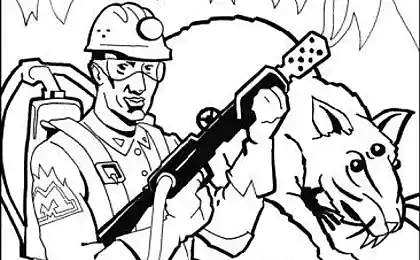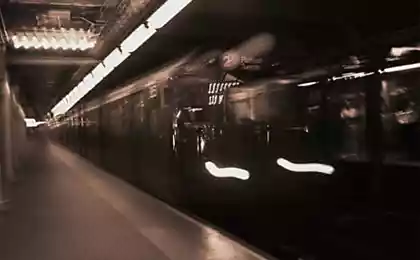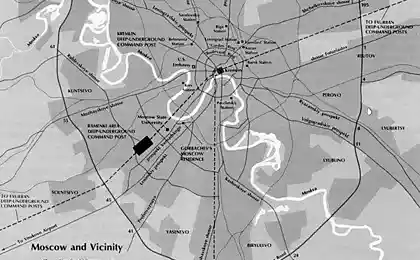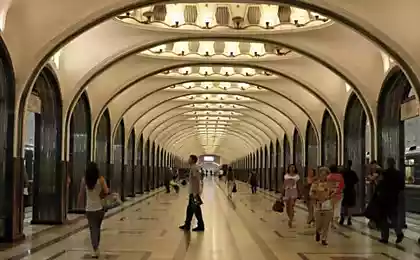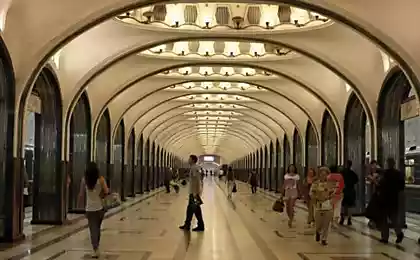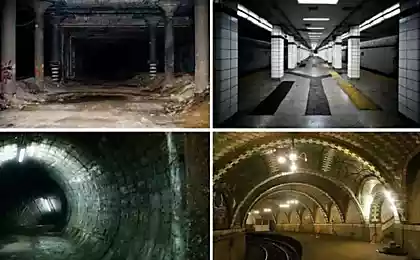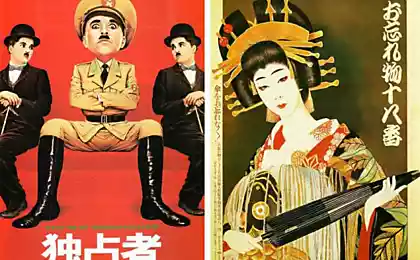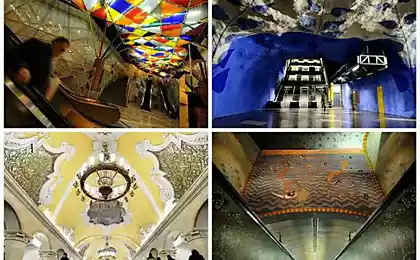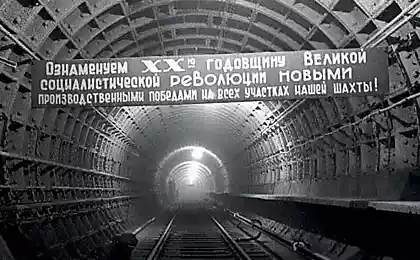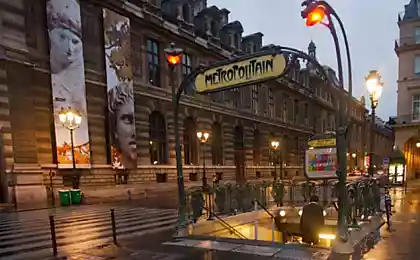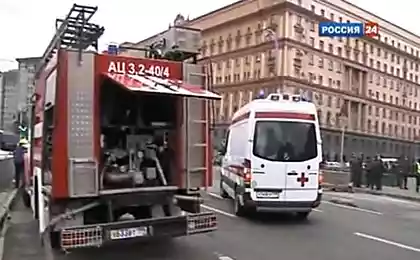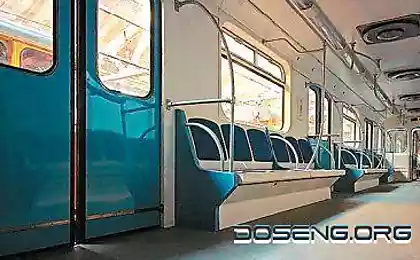782
Metrovagonmash: how to make the subway
During its long history Metrovagonmash has accumulated rich experience. In 1897 he was based as a car-building factory, then mastered the production of tracked vehicles, later in conjunction with AMO "ZIL" dump produced. Now Mytishchi Metrovagonmash is the home of almost all subway cars Russia.
At the moment, the main activity of the company is the issue of rolling stock subway, rail buses manufacturing and repairing.
48 photos via Sergei Pavlenko

02
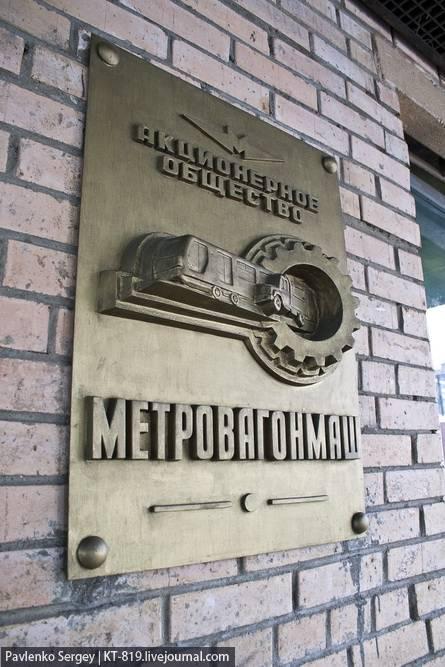
03
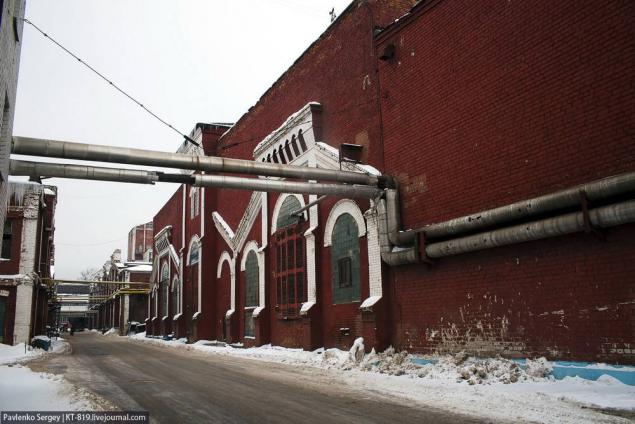
The main types of issued metrovagonov are currently 81-714.5 / 717.5, 81-740 / 741 and 81-760 / 761.
Last year the company produced 243 car underground car 32 rail buses will repair 113 subway cars. And repairing plant in conditions preferred for the same cost of repairing new equipment is installed, instead of the old repaired.
For the current year the Moscow Metro has ordered 320 cars. The volume is large and therefore it was decided to order the production of bodies in the Tver plant.
On the construction of the car takes about 70 hours. The car starts with the body, it is made in the welding shop.
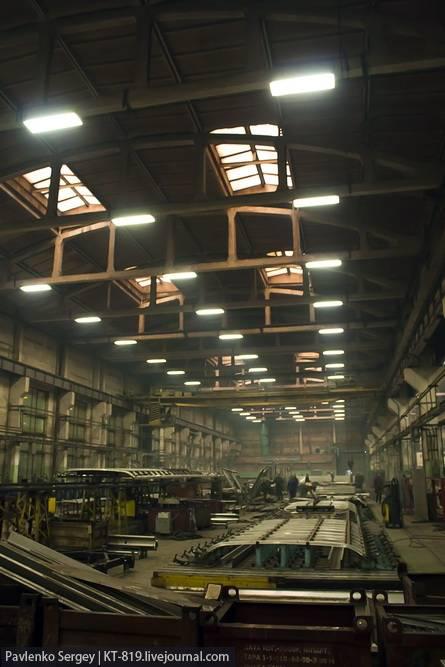
The shop resembles a clip Rammstein. Under the ceiling of smoke, sparks around, crashing and all merges and falls after the frosty air the factory site.
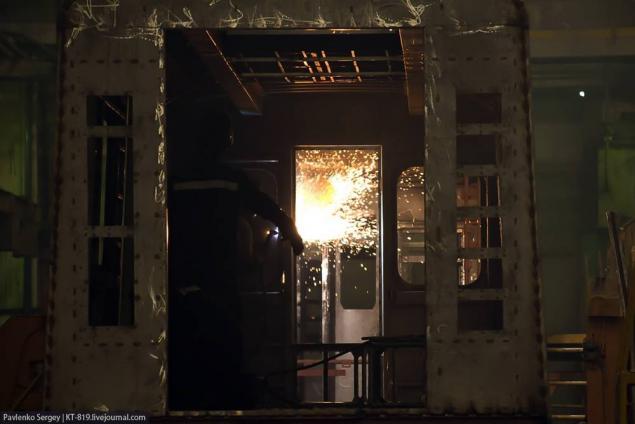
This plant kingdom welding. Here, from the individual pipe, profile and sheet metal blanks skillful hands create the "body" of the car.
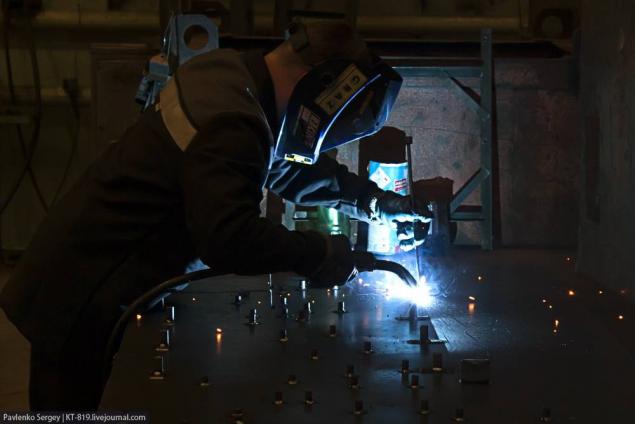
07
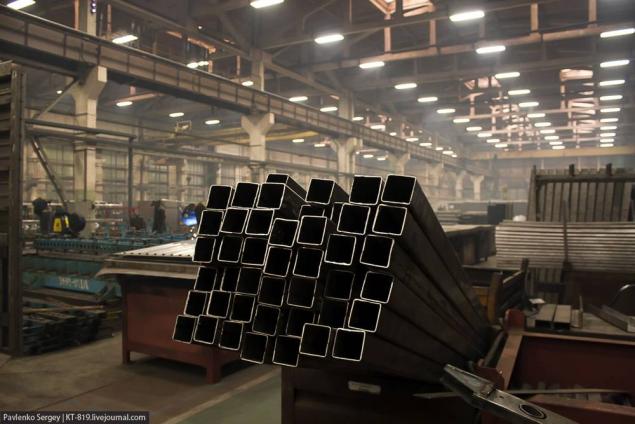
08
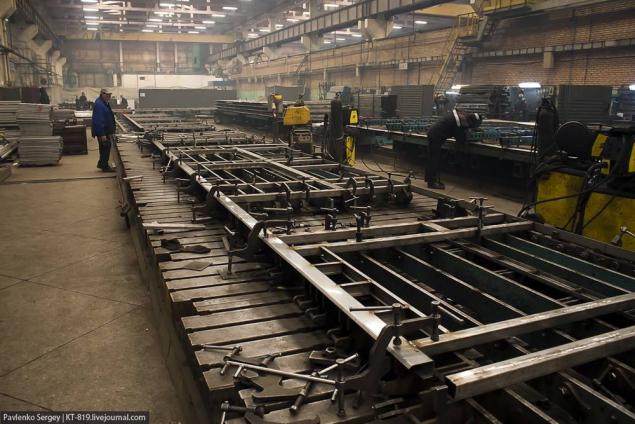
Metal cut, fitted, secured and welded bench. separately produced frame, the roof and the walls of wagons.
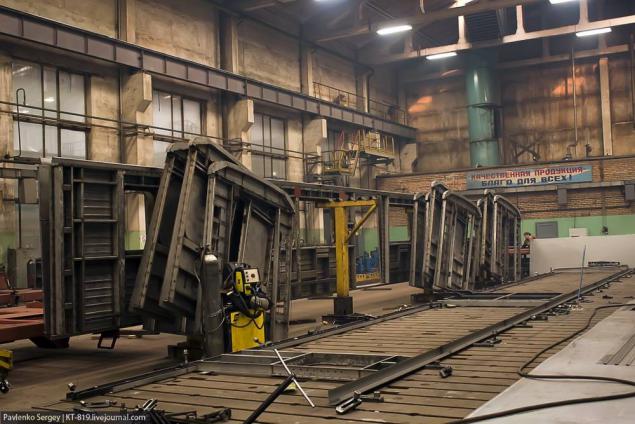
Next comes the final assembly of the body, it is already possible to know the outline of the car.
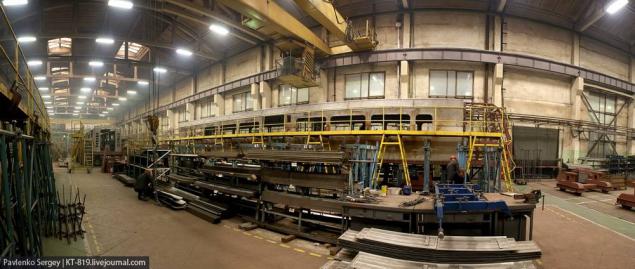
11
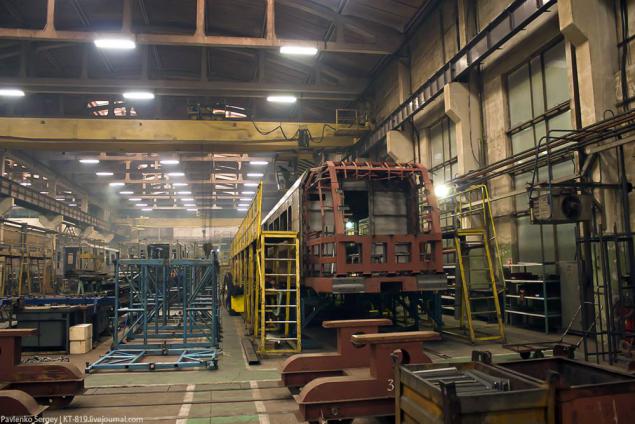
12
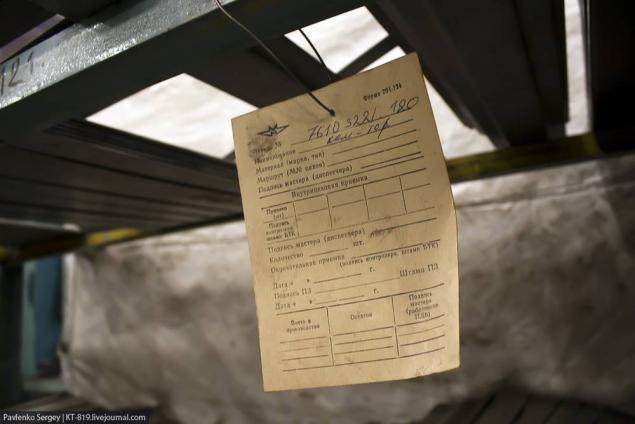
In parallel, made trolley cars.

Then the body through a parking place on transborder routes.

They also found the body brought from Tver, they are completely packed in a white film.
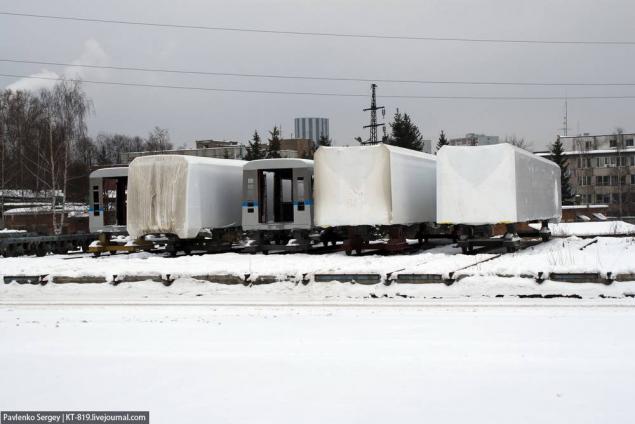
Next, the body is primed and painted. paint shop combined with a workshop debugging.
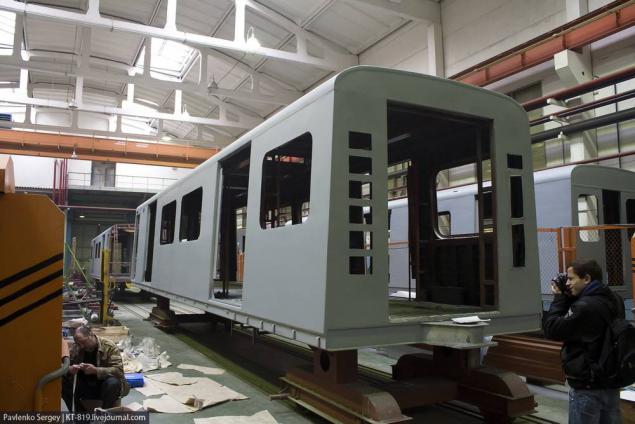
Here on primed fiberglass body wear a mask. The product, though extensive, but relatively easy.

18

Further applied color and paint cars.
Interior that is not attractive.
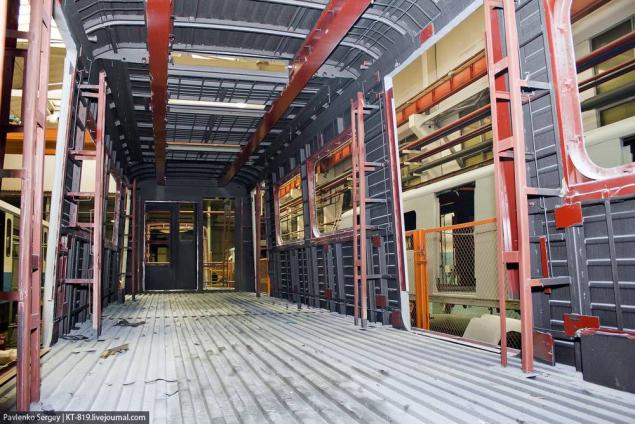
Next painted body is transferred to the assembly plant.
The first workshop, which was for the production of cars had number 17 and is now in the memory of it all and the three-digit number of shops and end this figure.

The shop number 217 make installation of equipment on the body.
The whole plant is filled with cars in varying degrees and for different subways.
For example the right head coach will leave for Kazan.
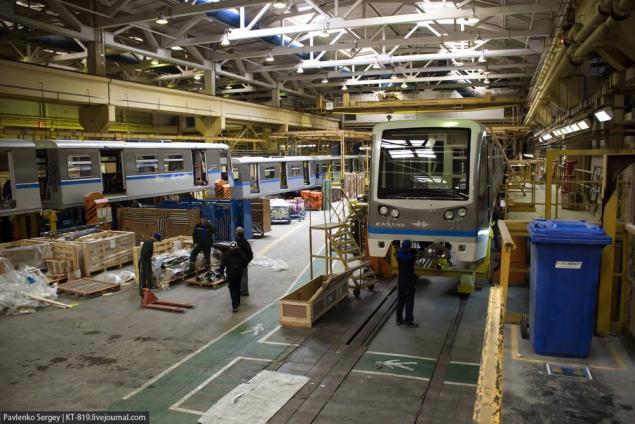
22
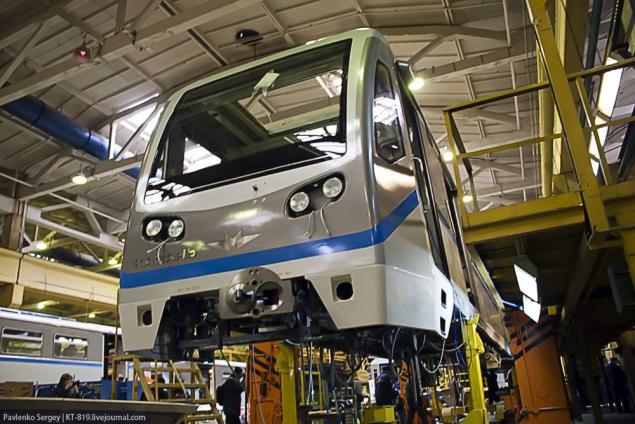
For easy installation, the body of the car is raised on jacks. Below it is possible to go without opaseniya- it securely in place.
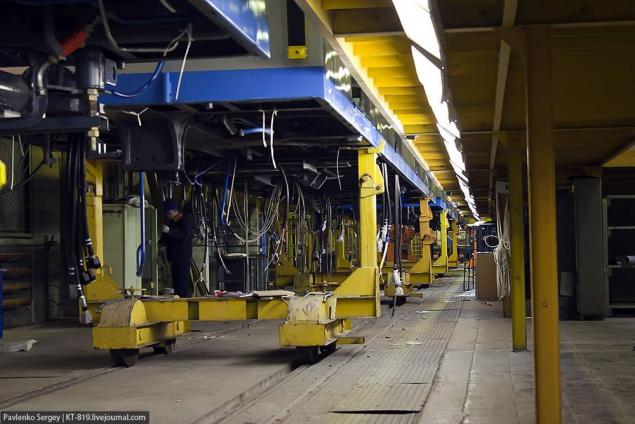
The plant introduced "lean production". All parts are made strictly in the required quantity, well thought out storage items, their availability and the ability to apply the desired part. Thereby minimizing the downtime of workers and equipment.

25
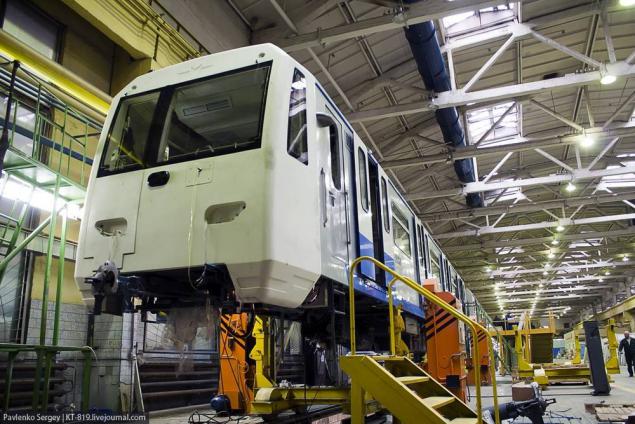
Located under the car engine control systems, pneumatic systems and battery packs. The batteries are required to run the car after disconnecting it from the catenary, such as during an overnight stay.
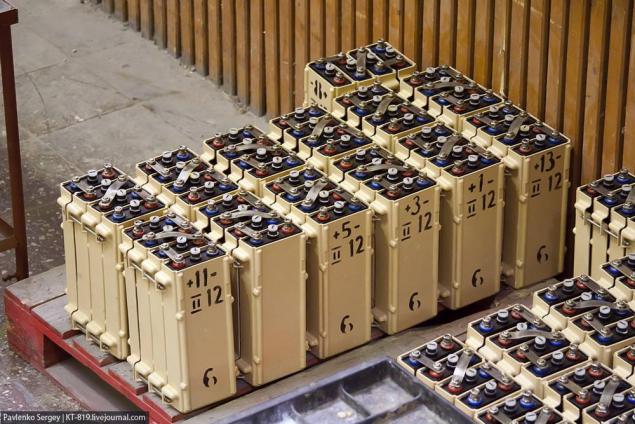
In parallel routed wiring and insulation.
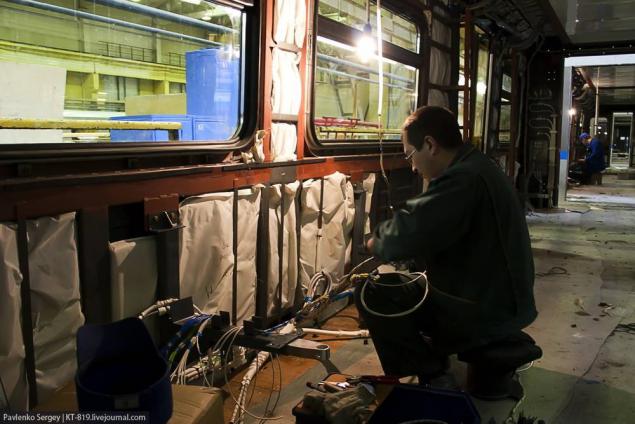
28
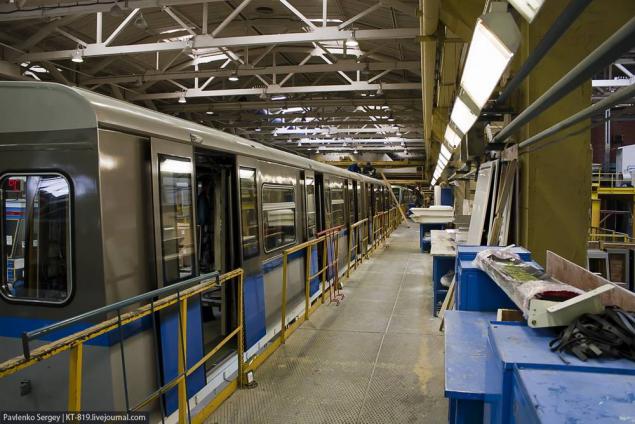
In contrast to the "license" in new cars more intelligent electronics. Since they require asynchronous motors AC and in catenary it is permanent, so you want to install a so-called inverter. It allows not only to control the motor, but also to recover energy during braking, returning to 50% of the electricity back to the grid.

30
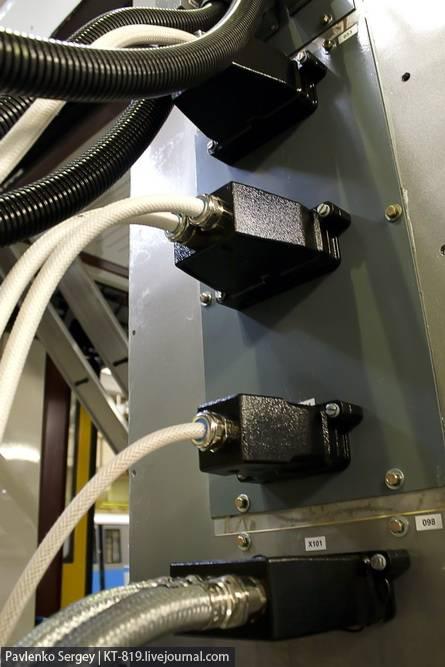
31
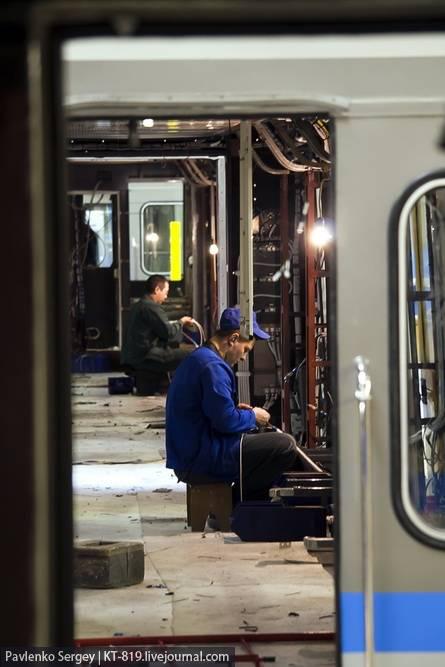
Unfortunately, in the Russian trains more foreign equipment. This requirement is quality. The Russian partners can not offer the same efficient and reliable systems, as European.
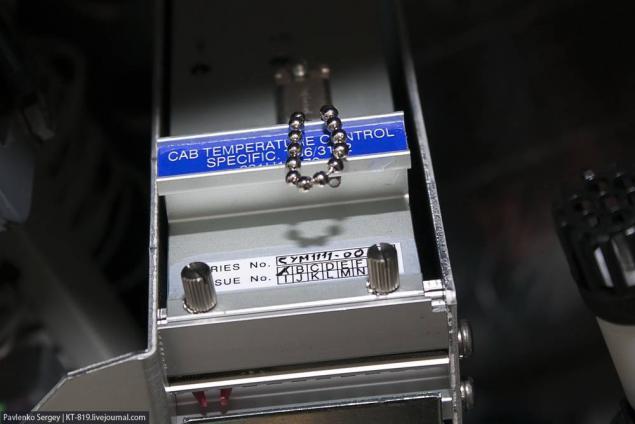
33

Cars series 740/741 were designed for Butovo light metro line, so they are oriented to work outdoors, they like buses have flexible joint, and modern urban design. However, they have shown excellent characteristics and exploited and in tunnels, too.
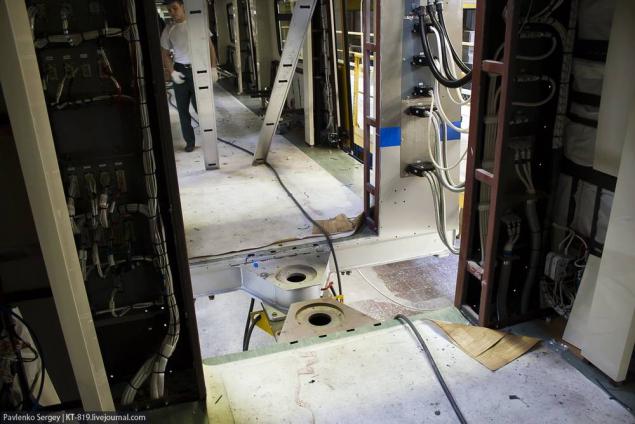
In the "accordion" hidden cables, and itself "accordion" comes packed in a film.

36
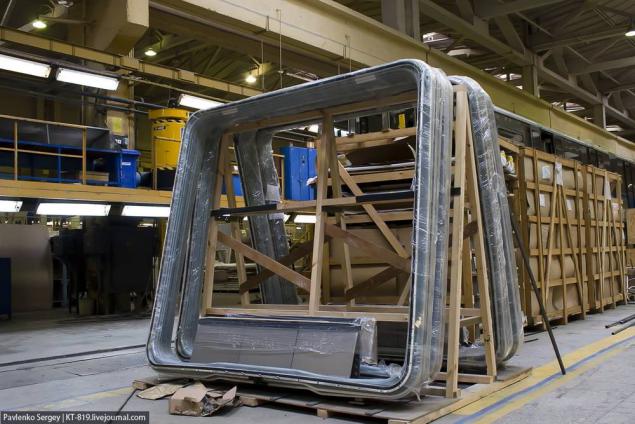
After the end of the assembly and fitting the car becomes a finished look and lowered onto the truck. And on its wheels is sent to the coloring and debugging workshop.
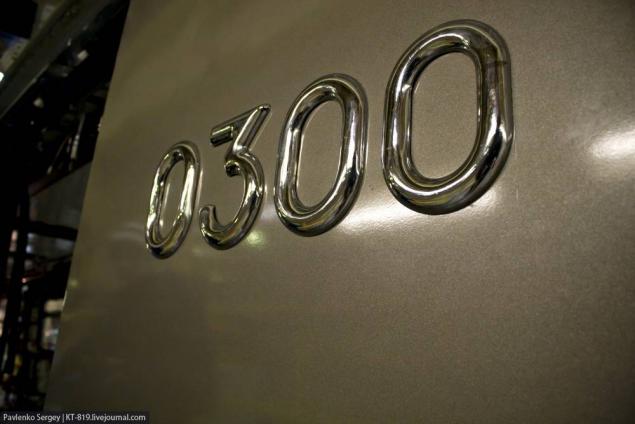
38
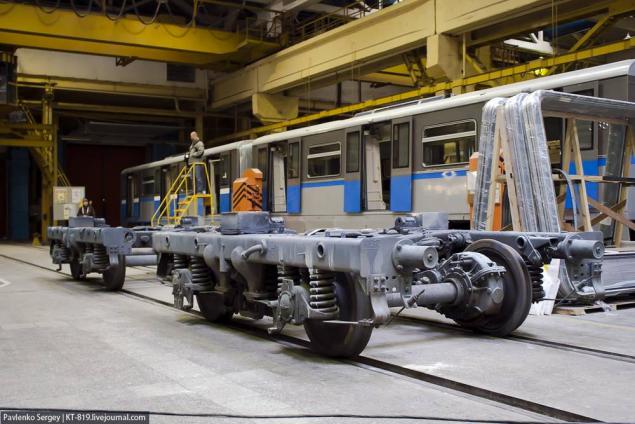
The debug shop check the operation of all systems, finish and dopodklyuchayut components applied labels.

Check the dimensions of the car a special frame.
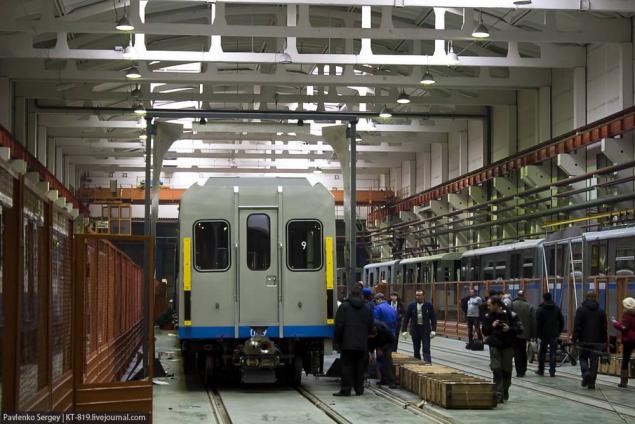
One of the most important tests are running tests. The plant has a branch length is only a kilometer from the top of the contact network. that cars could be powered from her roof mounted pantographs, both on the train and connect the cables and hoses.
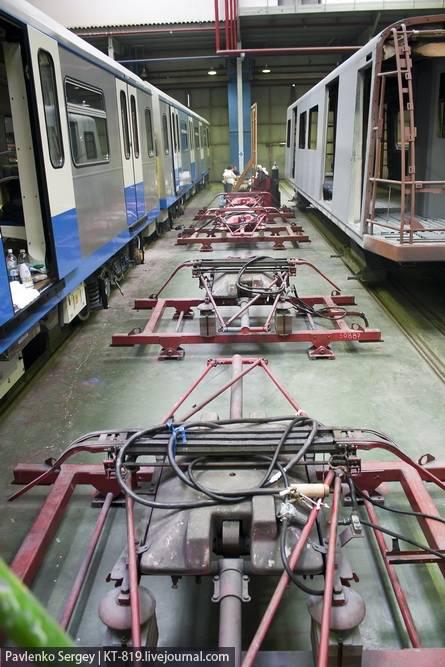
The plans to build a separate plant Metrovagonmash acceptance of the finished product, this would not put the cars ready in the assembly hall and a separate room.
Life begins rail bus elsewhere. They are produced in a separate building.
The main distinguishing feature of this type of transport is the availability of a diesel engine, which allows travel on any railway line, regardless of electrification.
Appointment rail bus is malozagruzhennye branches where there is no need for large diesel trains, they are often bought as a staff car. Boxer engine does not require a lot of space and is located under the floor leaving a maximum of space for passengers ...
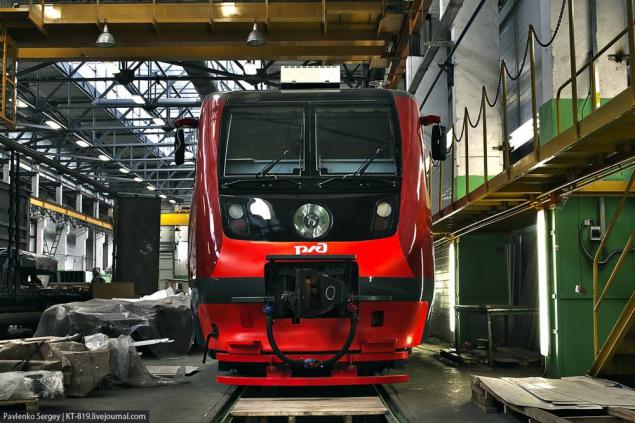
Beautiful plastic kit, streamlined shape and bright gloss paint make the PA-2 is very attractive.
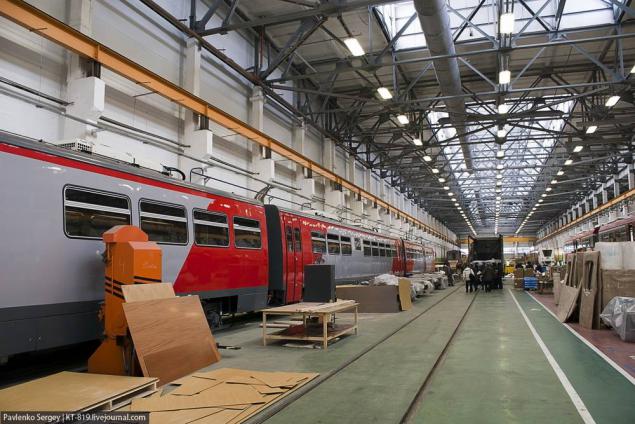
In parallel, in the same shop going diesel trains for Serbia. There will be made 12 dvuhvagonnyh compositions. In appearance they are not similar to any of the Russian train.
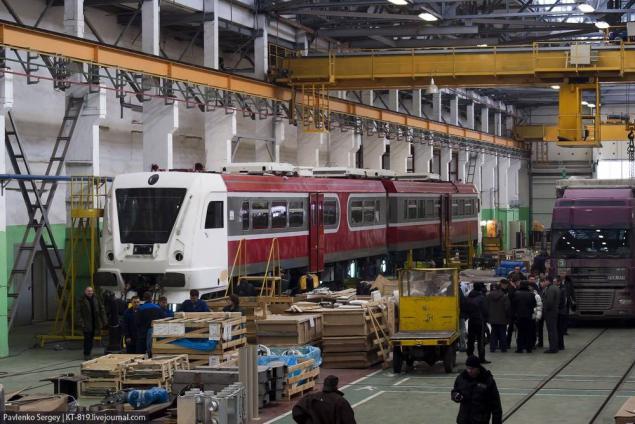
On the site of the bridge crane is perfectly visible orderliness and organization of lean production. All the details are in place, indicated by markings on the floor.

Earlier Metrovagonmash had almost a full cycle of production, but the complexity of production and market conditions forced the transfer of the production of specialized factories, etopovysit quality and reduce the cost of maintaining and upgrading equipment in these plants. Sharply reduced molding and forging production, decreased the amount of work in the thermal workshop.

47
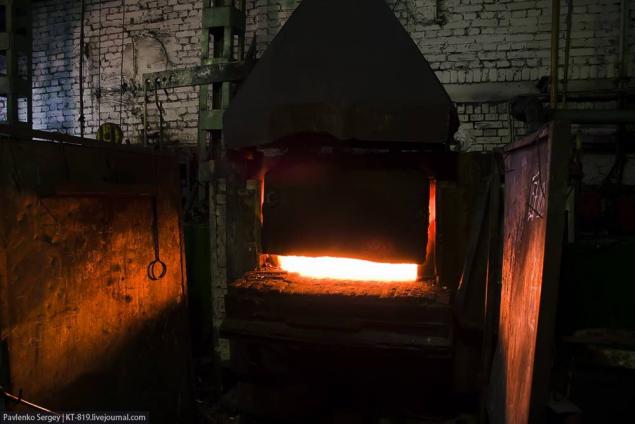
48
Metrovagonmash is steady growing company that provides an important mode of transport with modern quality and comfortable cars in Russia, CIS and several European countries. Product quality is evaluated on a daily basis by more than fifteen million passengers.
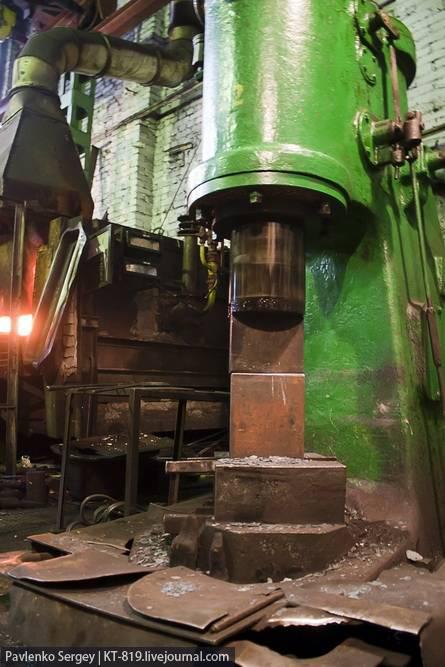
Source:
At the moment, the main activity of the company is the issue of rolling stock subway, rail buses manufacturing and repairing.
48 photos via Sergei Pavlenko

02

03

The main types of issued metrovagonov are currently 81-714.5 / 717.5, 81-740 / 741 and 81-760 / 761.
Last year the company produced 243 car underground car 32 rail buses will repair 113 subway cars. And repairing plant in conditions preferred for the same cost of repairing new equipment is installed, instead of the old repaired.
For the current year the Moscow Metro has ordered 320 cars. The volume is large and therefore it was decided to order the production of bodies in the Tver plant.
On the construction of the car takes about 70 hours. The car starts with the body, it is made in the welding shop.

The shop resembles a clip Rammstein. Under the ceiling of smoke, sparks around, crashing and all merges and falls after the frosty air the factory site.

This plant kingdom welding. Here, from the individual pipe, profile and sheet metal blanks skillful hands create the "body" of the car.

07

08

Metal cut, fitted, secured and welded bench. separately produced frame, the roof and the walls of wagons.

Next comes the final assembly of the body, it is already possible to know the outline of the car.

11

12

In parallel, made trolley cars.

Then the body through a parking place on transborder routes.

They also found the body brought from Tver, they are completely packed in a white film.

Next, the body is primed and painted. paint shop combined with a workshop debugging.

Here on primed fiberglass body wear a mask. The product, though extensive, but relatively easy.

18

Further applied color and paint cars.
Interior that is not attractive.

Next painted body is transferred to the assembly plant.
The first workshop, which was for the production of cars had number 17 and is now in the memory of it all and the three-digit number of shops and end this figure.

The shop number 217 make installation of equipment on the body.
The whole plant is filled with cars in varying degrees and for different subways.
For example the right head coach will leave for Kazan.

22

For easy installation, the body of the car is raised on jacks. Below it is possible to go without opaseniya- it securely in place.

The plant introduced "lean production". All parts are made strictly in the required quantity, well thought out storage items, their availability and the ability to apply the desired part. Thereby minimizing the downtime of workers and equipment.

25

Located under the car engine control systems, pneumatic systems and battery packs. The batteries are required to run the car after disconnecting it from the catenary, such as during an overnight stay.

In parallel routed wiring and insulation.

28

In contrast to the "license" in new cars more intelligent electronics. Since they require asynchronous motors AC and in catenary it is permanent, so you want to install a so-called inverter. It allows not only to control the motor, but also to recover energy during braking, returning to 50% of the electricity back to the grid.

30

31

Unfortunately, in the Russian trains more foreign equipment. This requirement is quality. The Russian partners can not offer the same efficient and reliable systems, as European.

33

Cars series 740/741 were designed for Butovo light metro line, so they are oriented to work outdoors, they like buses have flexible joint, and modern urban design. However, they have shown excellent characteristics and exploited and in tunnels, too.

In the "accordion" hidden cables, and itself "accordion" comes packed in a film.

36

After the end of the assembly and fitting the car becomes a finished look and lowered onto the truck. And on its wheels is sent to the coloring and debugging workshop.

38

The debug shop check the operation of all systems, finish and dopodklyuchayut components applied labels.

Check the dimensions of the car a special frame.

One of the most important tests are running tests. The plant has a branch length is only a kilometer from the top of the contact network. that cars could be powered from her roof mounted pantographs, both on the train and connect the cables and hoses.

The plans to build a separate plant Metrovagonmash acceptance of the finished product, this would not put the cars ready in the assembly hall and a separate room.
Life begins rail bus elsewhere. They are produced in a separate building.
The main distinguishing feature of this type of transport is the availability of a diesel engine, which allows travel on any railway line, regardless of electrification.
Appointment rail bus is malozagruzhennye branches where there is no need for large diesel trains, they are often bought as a staff car. Boxer engine does not require a lot of space and is located under the floor leaving a maximum of space for passengers ...

Beautiful plastic kit, streamlined shape and bright gloss paint make the PA-2 is very attractive.

In parallel, in the same shop going diesel trains for Serbia. There will be made 12 dvuhvagonnyh compositions. In appearance they are not similar to any of the Russian train.

On the site of the bridge crane is perfectly visible orderliness and organization of lean production. All the details are in place, indicated by markings on the floor.

Earlier Metrovagonmash had almost a full cycle of production, but the complexity of production and market conditions forced the transfer of the production of specialized factories, etopovysit quality and reduce the cost of maintaining and upgrading equipment in these plants. Sharply reduced molding and forging production, decreased the amount of work in the thermal workshop.

47

48
Metrovagonmash is steady growing company that provides an important mode of transport with modern quality and comfortable cars in Russia, CIS and several European countries. Product quality is evaluated on a daily basis by more than fifteen million passengers.

Source:
